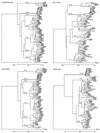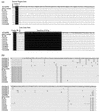Characteristics of hepatitis B virus isolates of genotype G and their phylogenetic differences from the other six genotypes (A through F)
- PMID: 12021346
- PMCID: PMC136184
- DOI: 10.1128/jvi.76.12.6131-6137.2002
Characteristics of hepatitis B virus isolates of genotype G and their phylogenetic differences from the other six genotypes (A through F)
Abstract
Eight hepatitis B virus (HBV) isolates of genotype G were recovered from patients and sequenced over the entire genome. Six of them had a genomic length of 3,248 bp and two had genomic lengths of 3,239 bp (USG15) and 3,113 bp (USG18) due to deletions. The 10 HBV/G isolates, including the 8 sequenced isolates as well as the original isolate (AF160501) and another isolate (B1-89), had a close sequence homology of 99.3 to 99.8% among themselves (excluding USG18 with a long deletion) but of <88.7% to any of the 68 HBV isolates of the other six genotypes with the full-length sequence known. The eight HBV/G isolates possessed an insertion of 36 bp in the core gene and two stop codons in the precore region, as did the AF160501 and B1-89 isolates. The 10 HBV/G isolates clustered on a branch separate from those bearing the other six genotypes (A through F [A-F]) in the phylogenetic tree constructed from full-length sequences of 78 HBV isolates as well as in those constructed from the core, polymerase, X, and envelope genes. Despite two stop codons in the precore region that prohibited the translation of the HBV e antigen (HBeAg), all of the eight patients with HBV/G infection possessed the HBeAg in serum. By restriction fragment length polymorphism of the surface gene, all of the eight patients were found to be coinfected with HBV of genotype A (HBV/A), which would be responsible for the expression of HBeAg in them. It is worthy of examination to determine how coinfection occurs and whether HBV/G needs HBV/A for replication.
Figures



References
-
- Bhat, R. A., P. P. Ulrich, and G. N. Vyas. 1990. Molecular characterization of a new variant of hepatitis B virus in a persistently infected homosexual man. Hepatology 11:271-276. - PubMed
-
- Carman, W. F., M. R. Jacyna, S. Hadziyannis, P. Karayiannis, M. J. McGarvey, A. Makris, and H. C. Thomas. 1989. Mutation preventing formation of hepatitis B e antigen in patients with chronic hepatitis B infection. Lancet ii:588-591. - PubMed
-
- Chayama, K., Y. Suzuki, M. Kobayashi, A. Tsubota, M. Hashimoto, Y. Miyano, H. Koike, I. Koida, Y. Arase, S. Saitoh, N. Murashima, K. Ikeda, and H. Kumada. 1998. Emergence and takeover of YMDD motif mutant hepatitis B virus during long-term lamivudine therapy and re-takeover by wild type after cessation of therapy. Hepatology 27:1711-1716. - PubMed
-
- Felsenstein, J. 1985. Confidence limits on phylogenesis: an approach using the bootstrap. Evolution 39:783-791. - PubMed
-
- Gojobori, T., K. Ishii, and M. Nei. 1982. Estimation of average number of nucleotide substitutions when the rate of substitution varies. J. Mol. Evol. 28:414-423. - PubMed
MeSH terms
Substances
Associated data
- Actions
- Actions
- Actions
- Actions
- Actions
- Actions
- Actions
- Actions
LinkOut - more resources
Full Text Sources

